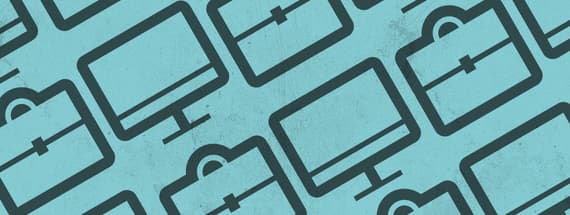
How to Create a Great Portfolio Part 1: 3 Tips & Tricks
When working as a freelancer, your portfolio is your calling card. It's your résumé. It's the most important thing. Nobody cares about your studies or how long you've been at it. Everyone cares about the quality of your work. That's why it's important to have an awesome portfolio that makes you stand out.
Now, the portfolio is a great tool to get a job. But how do you build it? Do you just pour all of the projects you've ever worked on in there? Do you just pick the best of them? Do you just stick to the collection of your work format or do you go for something extra? That's up to you entirely, but you need to keep in mind that the choices you make when creating your portfolio will directly affect the kind of customers you attract and their number.
Say you make a living as a designer. You've probably created both vector packs and all kinds of illustrations. You may have worked both for tattoo parlors and private health clinics. If you cram your portfolio full of the work you've done for tattoo parlors and not so much of the work you've done for other kinds of clients, odds are you'll attract a lot less banks or hospitals than tattoo artists. You see where we're going with this.
“I'm looking to expand my portfolio while I'm on top and I'm young.”Floyd Mayweather, Jr.
First of all, there's a huge difference between a portfolio and a pitch. A pitch is something you create for a specific customer, possibly referring to the exact job they're contracting you for. A portfolio is a collection of your best work. Don't get the two mixed up.
OK, so you're building your portfolio with a kind of customer in mind. Then what? What makes you stand out from the rest? The work you put in there? Yes, that's important, but not enough. There's plenty of designers out there who do great work and, odds are, some of them are better than you. But that's all right. You can build your portfolio in such a way that it stands out. Here's how.
An online portfolio is better than offline

Now, when we say that online is better than offline, that's not a general rule of thumb, not even for portfolios. Sometimes, you'll meet a client that you're going to want to have an offline portfolio for, because they're old-fashioned and just prefer it. What it does mean, though, is that having an online portfolio in addition to any printed copies you have for that particular type of client is going to open a world of possibility for you.
Having an online portfolio … is going to open a world of possibility for you.
For one thing, your online portfolio is more visible. More potential clients will check out your portfolio if it's online, because they may just stumble across it. This means more job offers in the long run. Keep your printed portfolio, give it to clients, just so they have it lying around the office, it's a great idea, but the online portfolio will bring you new work you'd find yourself without should you choose not to have an online portfolio.
Then, this brings about another question: where do you build your online portfolio? There are two routes you can take. One of them is your own website, which is dedicated to you and your work. The other is using a specialized portfolio website, like Behance. Learn more about how to create a successful online portfolio in Part 2 of this series.
What are the pros and cons of each one of these options? Well, a dedicated website can showcase your work better than any portfolio site, because it's all about you. Pull it off right, and the world is your oyster. The problem is that it's a lot harder to pull off. A good portfolio website means taking a lot of time and building it in a specific way, keeping in mind a lot of details (but more on that later).
On the other hand, a portfolio website like Behance or Dribbble is a great way to get started with a tried and tested design that really showcases your work. It also makes you a lot easier to find than a personal website, just because it means that everyone browsing that website for someone to hire can stumble across you.
Basically, if you're just starting out, you should probably go for the portfolio website and not jump in at the deep end and try to build your own website from scratch. If you're experienced and know what you're doing, go for the personal website. It's like playing a video game: you start out with the simpler missions and work your way up to the difficult ones by gathering experience.
What you show your potential clients is what they expect to get

Your clients can't know what you're going to deliver should they hire you. They can't expect to know how much you'll enjoy working on their project. The only thing that they can do is approximate that based on what you show them. Show them how you work when you're at your best, when you're passionate about the project, when you really love what you're doing. Don't just throw in a bunch of drab work you've only done for the paycheck. Show them the stuff that you did pro bono just because you thought the idea was cool. Show them a lot of varied work that you did and that you love.
It makes sense if you look at things from the client's perspective. Who would you hire? A pretty good designer who has one size fits all solutions all through his portfolio that's littered with bland work or one who's not brilliant either, but who puts all this effort and creativity in everything he does and who has a lot of different solutions for different projects — each one tailor-made for that particular project and that particular client?
I know this one designer who got hired at a big advertising agency because he submitted the most original portfolio he could think of. He just printed bits and pieces of all the design work he'd done over the years and pasted them over a mannequin, tagged the mannequin with his name and contact details, dropped it off at the firm headquarters, knocked and left. Think outside the box when creating your portfolio and you'll get the jobs you want to get.
Dress your website for success!

As we've discussed above, if you're going to create yourself a personal website, then you should be careful and pay attention to a whole lot of details. Here are some of them:
- First of all, you need a great logo. As a designer you probably know that the logo is one of the most important bits of a website and any brand identity for that matter. Why should your portfolio be any different? The only difference is that, for once, the brand you're creating is yourself. Make sure you put at least as much effort in your logotype as you would for any project-required one.
- Second, you need a great tagline. Usually this is not your job, if you're a designer. That's the job the copywriting folks do or that the customer will do himself. Your job is just the design. Not anymore. You're doing all the writing as well. The good thing is that you're the one who knows you best. Write a tagline that's short, catchy and summarizes what you do (or not – it could emphasize one of your qualities instead of letting people know you're a designer).
- Make sure the portfolio examples are high-resolution images …and that there's enough of them. Make sure that the website isn't cluttered. Make sure that your website lets people know what services you provide. Make sure you have an 'About me' section that lets people know who you are as a human being, and not only as a designer. Make sure people can contact you through your website. Make sure to use social networking websites to promote your website. Make sure to be friendly.
That concludes our list of tips for building a great portfolio. If you've got any more hints for people who are just starting to build their own, feel free to post them in the comments section below. Remember, you're only as good a designer as the work you do!


Comments